SHOWER JUST BEFORE GOING TO BED.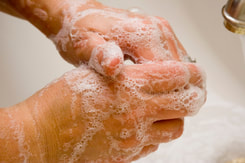 Keeping your hands away from your face is a cardinal rule in staying healthy. Considering that your hands and arms are touching things all day long, if you go to sleep without showering, or at least washing your arms, you'll be transferring germs from your arms to your pillow. And... if you sleep with your arm under your head, you're now exposing your face to those germs and those germs will enter your system through your eyes and nose. The simple solution is to take your daily shower just before going to sleep.
0 Comments
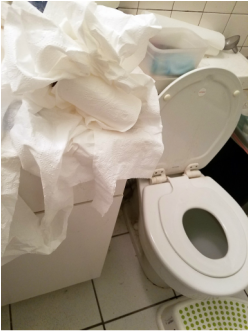 Thought the kitchen counter was the dirtiest thing in your home? You'll be surprised. You scrub the toilet bowl meticulously, wipe down your kitchen bench every evening and vacuum the carpet with precision. But some of the dirtiest items in your home may be the ones you don't often think of cleaning. Here is a list of some of the filthiest items in your home with a few tips on how to clean them: CLEANING EQUIPMENT How often do you clean your cleaning utensils? If your answer was not often enough, you're not alone. Sponges, cloths and scrub brushes are responsible for wiping up the biggest messes in your home, and these utensils are often one of the most germ-infested areas, with their damp material being a breeding ground for mould. To keep clean, be sure to rinse the utensil in hot water, wring out and leave to dry on a rack after every use and launder them every couple of days or when they start to smell. Most importantly, be sure to toss out sponges, cloths or rags every few weeks. DOORKNOBS Whenever we move into a different room of the house, we transfer any of the germs on our hands to the various doorknobs we touch. If left unclean, this results in the doorknob becoming one of the filthiest items in the house. To clean, use a cloth and hot, soapy water to wipe down, either weekly or as needed. KITCHEN SINK DRAIN The drain of your kitchen is filled with bacteria, with germ growth encouraged thanks to the combination of food scraps and moisture. Many experts believe the average kitchen sink is actually dirtier than your toilet seat. To ensure your drain is as germ free as possible, pour a cup of baking soda down the drain, followed by a cup of vinegar, finish by letting the mixture sit for a minute and then pour a kettle of boiling water down the drain. Use this inexpensive and eco-friendly cleaning method at least once a week and your drain should be in pristine condition. ELECTRONICS The average person uses the electronic devices in their home numerous times in a day, resulting in a large amount of bacteria building up on your remotes and keyboards. For example, the Wall Street Journal found the average mobile phone has up to 30,000 colony-forming units of bacteria. To ensure these devices are kept as clean as possible, swab your remote, keyboard, mouse and your mobile phone (including it's cover), once a week with a well wrung-out disinfectant wipe. BASE OF THE TOILET We all make sure to scrub the toilet seat and bowl. However, many people forget to clean the base of the toilet and surrounding floor, which, is surprisingly one of the filthiest areas of the bathroom (particularly if you have small children or men in the house). To keep this area clean, be sure to wipe down the base whenever you clean the toilet and mop the surrounding floor at least once a week. 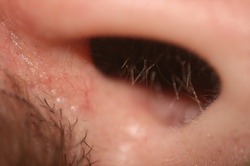 quoted from an article by Sarah Rohoman in Yahoo Canada StyleNovember 23, 2016 Did you know that plucking or trimming NOSE HAIR can be dangerous. "There’s an area on your face that the medical community has ominously named “the triangle of death.” The top point of the triangle is the bridge of your nose with the bottom of the triangle being above your upper lip. This area of your face is obviously close to your brain which makes getting infections in the triangle more dangerous than getting a cut on your knee. Not only is tweezing nose hairs incredible painful, it can leave the skin open from where you yanked the hair out. The hair in our nose is the first line of defense for filtering out the bad things we breathe in, so there’s plenty of germs trapped in there. The germs can then enter the body from the wound and cause an infection – staph, meningitis, etc. These scary bacteria can then infect the brain, leading to serious medical outcomes like paralysis or even death." The bottom line is DON'T PLUCK IN THE TRIANGLE. And don't pop pimples or pick your nose as either could leave your skin open to infection in vessels the feed the brain. Not a good situation. Monofoil
I was contacted by the makers Coeus Technology, makers of Monofoil. I am very impressed with the product, so I asked if I could post about it because, unlike most germ killing sprays or wipes which kill the "current" germs, Monofoil continues to kill germs on the surface for a long time after being applied.
Monofoil is a revolutionary new antimicrobial product that uses a physical action as opposed to a chemical action in destroying microbes. This antimicrobial product is being used by area hospitals, schools, professional sports organizations, and theme parks. Countries like China, Saudi Arabia, and Australia have recently been introduced to this new technology. Monofoil destroys algae, fungi, bacteria, and viruses by attracting the harmful microbes to it. Then the cell membrane is pierced, bled out and then electrocuted. The technology of Monofoil enables the product to remain intact to the substrate it is applied to. Allowing it to stay in place for up to 30 days as continues to work time and time again. This ready-to-use product is available in gallons, spray bottles, and wipes. Coeus Technology has recently added to its product line a new laundry additive. Thus allowing the clothes we wear to be protected for up to 50 washes. Better yet, Monofoil is hypo-allergenic, non-toxic, and safe to use around children and pets. One of the benefits of using Monofoil is the cost effectiveness of the product. It is fairly priced when you consider how long it lasts you. No more need for us germaphobes to buy chemicals that can be harmful to humans and have no longevity anyway. Another benefit is in the way the antimicrobial works. The way it kills a microbe is unique in that it does not simply poison the cell, but destroys it. Most chemicals will poison or sicken the microbe, allowing it to adapt to the chemical. This is how a “superbug” is formed and is definitely life threatening. Not the case with Monofoil. This product completely eliminates the problem and sticks around to do it again. Monofoil is unconditionally registered with the EPA and is made in the USA. Coeus Technology is a Disabled Veteran Owned Small Business located in central Indiana. The partners who started the company are both from Indiana and have studied biology at Indiana University. Both also served in the military for their country. I am neither sponsoring nor endorsing their product. It just looks like a "game changer" to me. Related articles I found this great article written by Angela Epstein in Mail Online on Dec 7, 2010 The experts’ rules for beating household bugs that can trigger heart disease, allergies and strokes Most of us never give a second thought to how long we’ve had that old chopping board – or those pillows, even that hairbrush. But while they may all look clean and serviceable enough, these seemingly innocent household items can actually harbour potentially harmful bacteria if used too long, regardless of how often they’re cleaned. Here, with the help of scientific experts, we examine how often you should spring clean those everyday household items – and when it’s time to simply throw them in the bin . . . 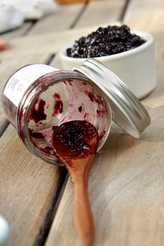 WOODEN SPOONS Wood is more porous than plastic or metal, making it more susceptible to carrying germs and bacteria, explains John Oxford, Professor of Virology at Barts and the London Hospital. The bacteria particularly prevalent in the kitchen is E. coli, usually from raw meat or children with poor hygiene habits. This can lead to severe food poisoning. Beware: Seemingly innocent household items can harbour harmful bacteria Don’t put wooden spoons in the dishwasher, especially not on a regular basis, as they may crack and therefore provide a haven for bacteria. Instead, soak in disinfectant for about half an hour and then wash with boiling soapy water. REPLACE: After five years, but earlier if the wood cracks, or if any part becomes soft or dark, as this could mean the wood is rotting and retaining bacteria. 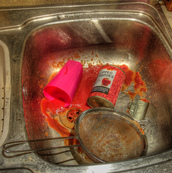 Kitchen Kitchen Sink. In the Kitchen, wash anything that comes in contact with food. The biggest culprit in the kitchen is the sponge. Sanitize it once in a while. The toilet bowl – well, you might expect this, but you should buy toilet seat wipes for the restrooms you share with guests The garbage can – especially if you don’t use trash bags in them The refrigerator – think about the old moldy foods that sit inside forever in an area that is rarely cleaned When washing dishes in the dishwasher, make sure the water temperature is at least 100 degrees Fahrenheit to properly disinfect. Instead of putting the sponge in the dishwasher to sanitize it,put the sponge in the microwave for at least two minutes. It kills more bacteria than a dishwasher. Or just use paper toweling and throw it away when done. Use separate cutting boards for raw meat and other food items, as the cracks and crevices on cutting boards provide space for bacteria to grow. Make sure to thoroughly clean the cutting board in between uses. Get into the habit of washing your hands frequently. Not only after using the bathroom, but after you finish eating, when you come home from work or school, after playing with pets, and especially after coughing, sneezing, or blowing your nose Bacteria can grow and divide every 20 minutes, allowing one single cell of bacteria to multiply more than 10 million times in 24 hours. The key is to locate the germ hot spots and tackle the germs as easily and quickly as possible. 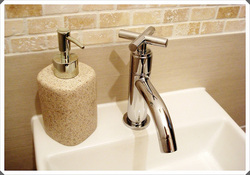 BATHROOM Toilet.The bathroom doorknob – stats say that most people don’t wash their hands after, and this is the first thing they all touch The flush handle on the toilet bowl – I take that back, this is the first place people touch after going to bathroom, even before they have a chance to wash their hands The toilet should be a priority when cleaning each week. Start by throwing away the ordinary and germ-ridden toilet brush. A better alternative is the Scrubbing Bubbles Fresh Brush. Its curved handle and interchangeable disposable cleaning pads work for both tough stains and easy touch-ups, making cleaning easier, quicker and less disgusting. Close the lid on the toilet seat every time you flush. The spray from the toilet flushing can spread germs. Unseen by the naked eye, this fine spray contains a range of viruses and bacteria, some of which can survive for hours or days on surfaces including exposed toothbrushes. Shake the shower curtain after each use and spread it open so moisture can evaporate. Clean shower curtains with a suitable disinfectant or launder them according to the manufacturer’s instructions. Rinse baths, sinks and showers after each use and clean them regularly to remove the lime scale and soap scum that can harbor germs. HOME AND OFFICE Phone receivers – if someone in your home is sick, this is the easiest place to catch those contagious germs Desktops – people never seem to wipe down desktops, though you spend 8 hours everyday touching it Keyboards – keyboards can be infested with boogers and germs over years of fingering Remove Shoes Shoes carry in a lot of dirt, dust and grime. They are a big source for tracking in germs all over your floors. These germs can settle down into carpet fibers Clean the Vacuum It is great that you vacuum. However, you need to remember to clean the vacuum. After each round of vacuuming, spray the entire vacuum with a disinfectant spray. This includes the inside of the canister, filters, bottom of the vacuum and handles. Germs love hard surfaces. If your vacuum is bagless, wash the canister between rounds of cleaning. Otherwise you’re spreading germs back into your home that are living on the hard, plastic surface of the canister. Clean Faucets Too often faucets are allowed to collect grime. The warm and moist bathroom air harbor germs. Faucets should be thoroughly cleaned weekly. Frequently spray faucets with a disinfectant spray. Put Bathroom Items Under the Sink Do you realize how many germs spray from a toilet that is flushed? If your sink and toilet are close to each other, you’re spraying germs on those toothbrushes that are in the holder. Put bathroom items that are near toilets under the sink. Disinfect Door Handles and Light Switch Plates Door handles and light switch plates are a harvest ground for germs. These areas should be sprayed with a disinfectant spray dai Found this enlightening article in Prevention Magazine online written by Alyssa Shaffer. It adds a few more places that I have to worry about germs. 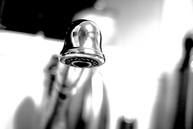 1. Kitchen Faucet That metal aeration screen at the end of the faucet is a total germ magnet. Running water keeps the screen moist, an ideal condition for bacteria growth. Because tap water is far from sterile, if you accidentally touch the screen with dirty fingers or food, bacteria can grow on the faucet, explains microbiologist Kelly Reynolds, PhD, an associate professor of community environment and policy at the University of Arizona College of Public Health. Over time, bacteria build up and form a wall of pathogens called biofilm that sticks to the screen. “Eventually, that biofilm may even be big enough to break off and get onto your food or dishes,” she notes. Keep It Clean: Once a week, remove the screen and soak it in a diluted bleach solution–follow the directions on the label. Replace the screen, and let the water run a few minutes before using. 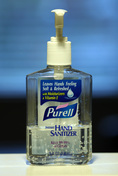 Ever notice that there are more commercials advertising antibacterial gels and related products? Every time I step into a grocery store there are antibacterial wipes for my shopping cart readily available. Or how about when you are waiting in line at the checkout stand? Chances are there’s a bin full of antibacterial products nearby. At the place where I work, there’s a Purel dispenser at every door entrance. Is it excessive? No. I’ll be the first to admit that I’m a germaphobe. And if something as simple as a modified strain of flu can take several lives, that’s enough proof to me that we need to have these products available to us at all times. Here are some key locations to keep antibacterial products handy. In your pocket! Think about all the things you touch and share with other people during the week. At work you come into contact with a number of co-workers and customers. You probably share the majority of office supplies and equipment, including computers, photocopiers, staplers, pens, with the entire company. On your days off you’re probably out doing chores. You’re touching door handles, shopping cart handles, toilet handles sink faucets in public restrooms, ATMs, meat at grocery stores. If you want to prevent yourself from contracting an infectious microbe, one rule of thumb to follow is that you sanitize after you leave each place you visit. You can do this by carrying around a small bottle of antibacterial gel that you can fit in your pocket or purse. At your kitchen sink. If you do a lot of cooking at home, you want to disinfect your hands before you touch the food which you are about to serve yourself and others. That’s health 101. But here’s something else to think about. Imagine all the dirty dishes that you put into your sink. So, you have germs from both people’s mouths and from food particles that become exposed and start to rot over time. Now, think about the sponge that you touch every time you wash the dishes. Chances are you don’t swap out your sponges everyday. Microbes can live for days on moist surfaces, which your sponge most definitely is the majority of times. Make it a habit to rub your hands with some antibacterial gel after you wash your dishes, and you will greatly reduce your exposure to infectious germs. At or near your dining room table. Our mouth being our largest orifice, it is the easiest path for dangerous microbes to take to get into our bodies. There is a reason why our parents pestered us about washing our hands before we ate, they didn’t want you to swallow down these microbes with your food! And if you’re a parent, you probably pester your own kids about washing their hands before they eat. But as you know, kids will seldom oblige to this request the first time. You probably have to tell them multiple times, or physically force them before they do it. Or they’ll simply lie about it. Sometimes you may even forget to tell your kids. Moreover, you as an adult, will sometimes fail to wash your hands before you eat. By having an antibacterial gel dispenser at your table, you will ensure that you and your family will have clean hands right before you serve the food, in case someone forgets or you suspect is lying about it. Related articles
|
Not Medical Advice
Everything in this blog is for entertainment and information only. It is NOT medical advice. Do not consider anything as medical advice and check with your physician before you take any action from any of our posts.
Categories
All
Archives
March 2020
AuthorI'm not in medicine. I'm just a mild germaphobe sharing information that I find. Interesting Sites |
 RSS Feed
RSS Feed
